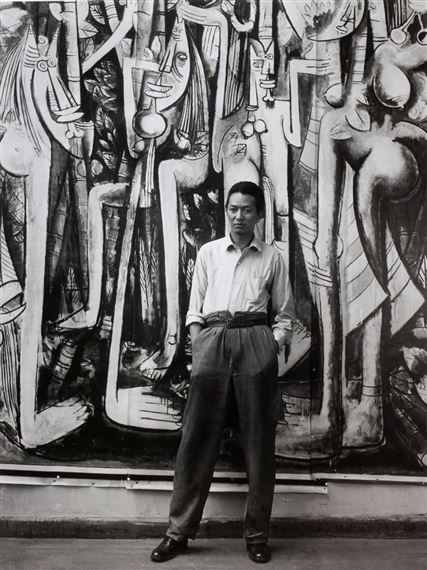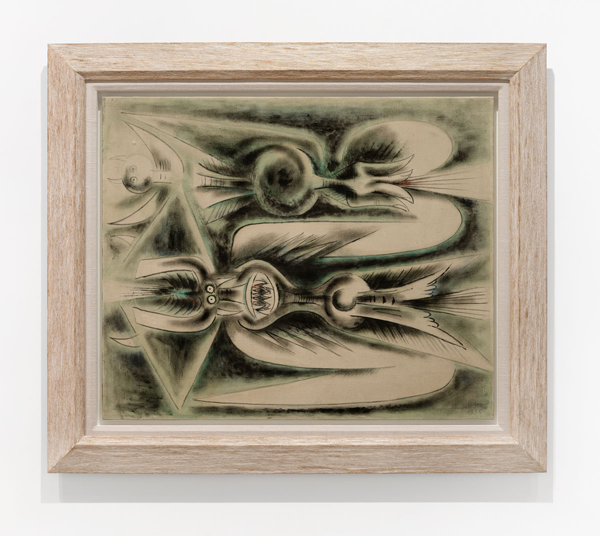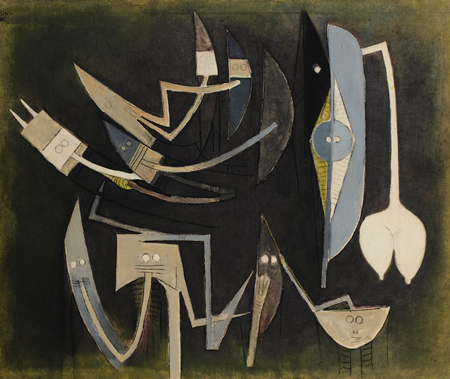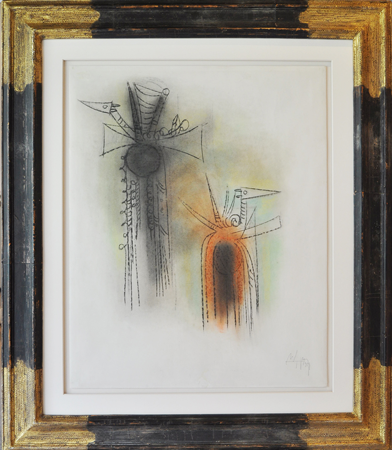A global artist of the twentieth century, Wifredo Lam fused elements from established concurrent artistic movements with Caribbean, African and Oceanic themes to create a style that was discernibly unique. Born on December 8, 1902 in Sagua la Grande, Cuba, to a Chinese father and Spanish/Congelese mother, Lam felt a deep connection with Caribbean culture and Afro-Cuban spiritual practices that were introduced to him by his godmother, Matonica Wilson, who was a Santería priestess. The latter would prove to be the most definitive and largest artistic influence.
While in Cuba he studied at the prestigious San Alejandro Academy. In 1923, he left for Madrid to pursue his artistic training. There, he studied under the tutelage of Fernando Sotomayor, Director of the Prado Museum and teacher of Dali. He became acquainted with a variety of styles and would firstly engage with Spanish modern academic technique, while later exhibiting a fondness toward more simplified compositions. In 1929, Lam married Eva Piriz. Two years later he would lose her and his newborn son to tuberculosis. This tragic event may have shaped some of the dark tendencies found in his work. Influence from Surrealism and inspiration from artists such as Matisse would take preference in his work of the 1930s.
In 1938, Lam traveled to Paris establishing a friendship with Picasso that would prove to be a formative encounter. With Picasso’s guidance and support, a young Lam was acquainted with many of the leading artists and intellectuals of the time, including Fernand Leger, Henri Matisse, Georges Braque, Joan Miro and more. Lam was also introduced to prominent art dealer, Pierre Loeb, who gave the budding talent his first solo show at the Galerie Pierre Loeb in Paris in 1939. That same year, he exhibited alongside Picasso at the world renowned Perls Galleries in New York.
With the onset of World War II, Lam spent most of his time traveling through the Caribbean, alongside his second wife Helena Holzer, and also with Claude Lévi-Strauus, André Masson, and André Breton, co-founder of Surrealism, whose poem “Fata Morgana” was illustrated by Lam in 1940. Elements from this series of illustrations became perpetually present in Lam’s later work relating to his iconic Femme Cheval. In 1941, Lam made his way back to Havana yielding a significant moment in his artistic development, and by the end of 1942 he had begun his powerful painting The Jungle, combining surrealism with the spirits and forms of the Caribbean. Lam’s exploration of mythic images paralleled that of his contemporaries in New York, the Abstract Expressionists, though Lam used more specific figures and subject matter.
Between 1942 and 1950, the artist exhibited regularly at the Pierre Matisse Gallery in New York. In 1946, after a four-month stay in Haiti, Lam returned to France via New York. Toward the end of 1948, through his friendship with Asger Jorn, he became acquainted with the prominent surrealist dissident group, CoBrA. His second marriage to Helena Holzer, ended in divorce in 1951. In 1954 Havana, Lam met distinguished art collectors, Edwin and Lindy Bergman to whom he sold several major works. This relationship solidified his connections to Chicago, a city known for its surrealist collections, and would lead to his ties to important Midwestern collectors. In May of 1955, Lam had a pivotal solo exhibition at the National Museum of Fine Art in Caracas, Venezuela, where he exhibited a formative body of work. In Manhattan in 1960, Lam married Swedish painter Lou Laurin with whom he had three sons Eskil, Timour, and Jonas. After a short stay in New York, they traveled to Chicago to visit the Bergmans and they met several collectors, Joseph and Jory Shapiro, Claire Zeisler, Leonard and Ruth Horwich, and art delear Richard Feigen.
In 1962, Lam established a studio in Albisola Mare, on the Italian coast where he would work for over twenty years. In 1963, Lam signed with his last exclusive dealer Galerie Krugier in Geneva. He exhibited in Philadelphia Collects 20th Century Art at the Philadelphia Museum of Art and in Paintings from the Museum of Modern Art at the Smithsonian Museum in Washington, D.C. In 1964, he received the Guggenheim International Award, and in 1966–67 there were multiple retrospectives of Lam’s work at the Kunsthalle Basel; the Kestner-Gesellschaft, Hannover; the Stedelijk Museum, Amsterdam; the Moderna Museet, Stockholm; and the Palais des Beaux-Arts, Brussels. In 1968, Lam was included in the itinerant exhibition at the Museum of Modern Art, Dada, Surrealism and Their Heritage. In 1972, an entire room was dedicated to the artist at the 36th Venice Biennale. He continues to exhibit and travel as a citizen of the world through the end of his life. Wifredo Lam died September 11, 1982, in Paris.
Recent years have seen a rediscovery of the artist in the way of seminal retrospectives including; Wifredo Lam in North America that traveled to four prominent institutions throughout the US; the Haggerty Museum in Milwaukee, the Miami Art Museum, Museum of Latin American Art in Long Beach, CA, and the Dali Museum in Tampa, FL. Imagining New Worlds was inaugurated and organized by the McMullen Museum at Boston College, an exhibition that later traveled to High Museum in Atlanta. Additionally, the artist was the subject of a comprehensive three museum retrospective; organized by the Centre Pompidou in Paris which later traveled to the Reina Sofia in Madrid, and the Tate Modern in London.
Today, the artist’s works are held in the permanent collections of the Chicago Art Institute, the Museum of Modern Art, the Guggenheim Museum, the Metropolitan Museum, the National Gallery of Art in Washington, D.C., the Centre Pompidou in Paris, Tate Gallery in London, the Reina Sofia Museum in Madrid, among many other institutions of worldwide prestige.
His works are characterized by the prominence of hybrid figures and styles, melding surrealism, magic realism, modernism, postmodernism, and the syncretic religion of Santería practiced in the Caribbean and West Africa. Blurring boundaries, his oeuvre does not belong to any particular art movement. Lam held the belief that society focused too much on the individual and sought to show humanity as a whole in his artwork, creating the universal.




